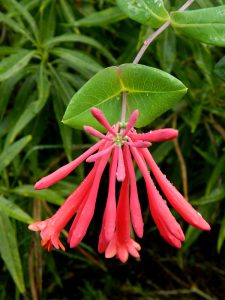Japanese honeysuckle (Lonicera japonica Thunb.) is one of the recent additions to the Florida State Noxious Weed List.
Belonging to the family Caprifoliaceae, alongside other popular vining and hardy shrub ornamental species, it is native to Eastern Asia. First introduced to Florida in 1875, it has been actively utilized as an attractive landscape ornamental, notably for its showy, fragrant spring and summer blooms. Historically, it was also once promoted by wildlife managers as winter forage for deer and highway designers to aid in erosion control and bank stabilization.

As a perennial, semi-evergreen plant here in Florida, it extensively twines, forming dense, woody thickets or mats, covering surrounding trees and shrubs and outcompeting many of our native plant species for space, light, water, and nutrients.
The leaves are petiolate, opposite, and leaf blades may be described as oblong, elliptic, or ovate-shaped. Upper and lower leaf surfaces are slightly pubescent. Younger stems will be reddish-brown in coloration and slightly pubescent, becoming hollow, smooth, darker brown in color and peeling with age, reaching lengths between 80-120 feet in length. Flowering generally occurs from April to July, with intermittent flowering throughout the year, and will appear solitary or in pairs. White or cream-colored, bilabiate corolla tubes eventually turn yellowish as they mature and are highly fragrant.

Young berries formed are green, turning black as they mature, and are moderately poisonous (saponic and cyanogenic gylcosides). Consumption of these berries in large quantities may lead to respiratory failure and coma in humans. This plant species spreads both sexually via seed dispersal by birds and other mammals which consume the berries, as well as asexually through vegetative reproduction.

Documented throughout the majority of the continental U.S. and Florida, it has been classified as a Category I invasive species by the Florida Exotic Plant Pest Council since at least the 1990s. This indicates that this species has significantly “altered native plant communities by displacing native species, changing community structure or ecological functions, or hybridizing with natives”. Freshly listed as State Noxious Weed, it is now “unlawful to introduce, multiply, possess, move or release any noxious weed or invasive plant regulated by the Florida Department of Agriculture and Consumer Services, except under permit issued by the department”.

Wait a minute, don’t we have a native honeysuckle species here in Florida? We do! The Florida native coral honeysuckle (Lonicera sempervirens L.) serves as an attractive, vining ornamental that provides abundant nectar and pollen resources for hummingbirds, butterflies, and moths. It can be distinguished from the invasive Japanese honeysuckle by its reddish, tubular flowers with a yellow interior. Another excellent indicator are the leaves of our native coral honeysuckle that are perfoliate, meaning the stem appears to pass through the middle of the leaf.
If you believe you have seen Japanese honeysuckle in a natural area, or need advice on how to safely remove it from your yard, contact your local county Extension office.
For more information on this invasive weed, check out FDACS-DPI Pest Alert, UF/IFAS Center for Aquatic and Invasive Plants, and Bugwood Lonicera japonica.
To learn more about the Florida native coral honeysuckle and where you can find it at your local nursery, check out: Florida Native Plant Society, Coral Honeysuckle, Florida Association of Native Nurseries, and the FNPS AlterNatives List.
 1
1
